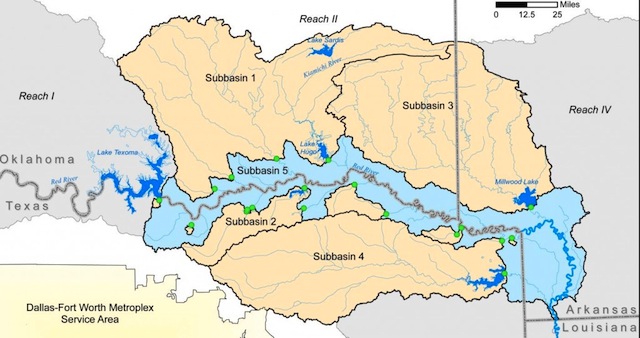Texas policymakers emphasizing additional water resources over conservation
On Thursday, June 11, 2013 the United States Supreme Court denied Texas’s claim to a stretch of the Red River, which extends into Oklahoma territory. This decision was the end of Tarrant Regional Water District’s (TRWD) $6 million attempt to secure more water for the rapidly growing Dallas-Fort Worth area. With increasing population in a state hard-hit by drought, this case is a prime example of the region’s desperate search for water.
As stated by Gary Allison, professor of law at Tulsa University, “Every day 34 million acre-feet of water flow out of Oklahoma in excess of all Oklahoma water uses. By contrast, 13.5 million acre-feet of water flow through the Colorado River every day. The Colorado’s flow provides water for Salt Lake City, Las Vegas, Phoenix, Tucson, and all of southern California from Los Angeles to San Diego and agricultural areas along the way. Then it enters Mexico where still more communities and farmland depend on it.” Given the vast amount of water flowing through the Red River, it is clear that Oklahoma’s water would be a plentiful and practical water source for Texas; especially considering its close proximity to the metropolitan areas of north and east Texas where water demand has spiked in recent years. Given its large and growing economy, Texas authorities have demonstrated a greater willingness to purchase water or secure it through legal means than manage the shortage through increased conservation measures. The prevailing water regulation cited by TRWD is the Red River Compact.
This compact – an interstate agreement signed by Texas, Oklahoma, Arkansas, and Louisiana in 1978 – ensures “equitable apportionment” of excess water in the Red River. TRWD was interested in Subbasin 5 located at Denison Dam to the west, stretching to the Arkansas border to the east, delineating the Texas-Oklahoma border in between and running along the Texas-Arkansas border until it ends at Louisiana. It is essentially the section of river, which forms the northeastern outline of Texas (depicted in the map above).
According to an article published by This Land Press, “The Red River Compact sets a minimum flow for the Red River through Subbasin 5: 3,000 cubic feet per second. That is, Louisiana is guaranteed that much water. If more than that makes it to Louisiana, the compact states that ‘excess’ water can be divided between the four states, with no state taking more than one quarter.”
Since much of the water in the Texas portion of the basin is too salty for consumption, TRWD sought to purchase 150 billion gallons of water from Oklahoma claiming that the Red River Compact gave them the right to do so. After the Oklahoma Water Resources Board denied the sale, discouraging moving water out of state, the district sued Oklahoma claiming the board was violating the Red River Compact and impeding interstate commerce. Because interstate commerce is a federal issue, the case was granted review by the Supreme Court.
The question at hand was whether Oklahoma should be forced to supply Texas with increasing amounts of water since the allotted 25% of excess water was too salty. The Oklahoma side, which was supported by the other states in the Red River Compact, did not see this as fair since they do not have a say in Texas water policy by voting for Texas legislators. According to an article published by Fox News, “Legislation adopted by the Oklahoma Legislature in 2009 said no out-of-state water permit can prevent Oklahoma from meeting its obligations under compacts with other states. It also requires the Water Resources Board to consider in-state water shortages or needs when considering applications for out-of-state water sales.” The Justices declared that the compact was not a 25% guarantee; the agreement stipulates only that member states cannot take more than that amount. So if a state does not get a quarter of the excess water, or in this case suitable water, it does not mean water can be taken from a neighboring state. Justice Sotomayor stated that “Tarrant’s claims lack merit,” and the Justices unanimously ruled that the Red River Compact “creates no cross-border rights in Texas.”
This case is significant because it sets precedent that the Supreme Court will recognize the sovereignty of the state rather than sanction apportionment of resources based on demand. With 23 other compacts in the U.S. similar to the Red River Compact, related cases are likely to follow in years to come. According to Think Progress, Texas has already allocated another $5 million to fund another legal battle over water access, this time with New Mexico. While conservation measures are not a preferred strategy for Texas, they may prove to be the most practical approach to solving the state’s water shortage – economic boom or not.
Devon Canady
Aerials and Historical Mapping
dcanady@banksinfo.com

